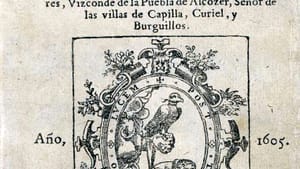Stay in the Loop
BSR publishes on a weekly schedule, with an email newsletter every Wednesday and Thursday morning. There’s no paywall, and subscribing is always free.
Reading into the music
Tempesta di Mare presents ‘Great Books: Classic Tales Illustrated for Orchestra’

Telling four riveting tales with nary a word, Tempesta di Mare closed its season with a thrilling concert in the Kimmel Center’s embracing Perelman Theater. You might expect that a concert titled Great Books would include vocals, as Tempesta often does. But here—in a robust, engaging evening that was clever without comment and referential without being arcane—Tempesta directors Gwyn Roberts and Richard Stone programmed four works that illuminated classic manuscripts and entered the literary world through an instrumental door.
This highly praised Baroque orchestra often concertizes in smaller configurations. But it’s always a great treat when the big band takes the stage: 22 deeply gifted musicians, sans conductor, playing with snap, joy, and forward motion (aptly, for much of this was dance music).
Fairy Queen and Midsummer
This programmatic concert featured descriptive music created to embellish four enduring literary works. It opened with iconic English composer Henry Purcell (1659-1695) and his music from The Fairy Queen masque. Highly dramatic and often allegorical spectacles filled with scenery and dance, masques were musical interludes inserted into a stage work. The Fairy Queen (performed in London in 1692) is incidental music for Shakespeare’s A Midsummer Night’s Dream.
In these airs, hornpipes, rondeaus, and dances, Tempesta perfectly captured the vibrancy of Purcell’s luscious, charming, and seductive music for this great comedy. Nine pieces ran a musical gamut, from the charming “Monkey’s Dance”—where the strings played col legno (musicians bouncing their bows)—to an exceptionally beautiful and elegantly interpreted chaconne that ended the set.
Cervantes and Telemann
The next book to open its pages was Cervantes’s The Ingenious Gentleman Don Quixote of La Mancha. The novel was written in 1605, and so—like Purcell—Georg Philipp Telemann (1681-1767) was looking back at what was already a classic. Telemann’s Burlesque de Quixotte magically captures the essence of the comic tale undergirded by the hero’s quixotic grace and optimism. The eight pieces in this suite are wildly descriptive: The Overture is both majestic and silly, and the set romps through works that illustrate the hero tilting at windmills (dazzling 16th-note runs) or sighing for the fair Dulcinea (motifs of longing). And the “Gallop of Rosinante” juxtaposes the gait of Quixote’s dubious steed with the braying of Sancho’s donkey.
In this masterpiece of programmatic composition, both Tempesta and Telemann stand out among peers. The star composer of his age, Telemann imbues this programmatic work with incredibly specific, sometimes haunting musical detail that brings the novel alive, especially in Tempesta’s visceral reading. Mirroring the musical contrasts throughout, the suite ended unexpectedly: Wonderful violinist Emlyn Ngai played al niente—notes lingering so delicately that you could hear his string vibrate as the sound evaporated.

True musical fireworks
After intermission, Tempesta returned with slightly smaller forces in a French work that (unlike those in the first half) was written concurrently with its literary inspiration. Marc-Antoine Charpentier (1643-1704) created incidental music to accompany Molière’s 1673 play The Imaginary Invalid. Charpentier (engaged to replace Jean-Baptiste Lully, who fell out with the author) wrote this score for a form Molière invented and called comédie-ballet. These were theatricals created for Louis XIV (who sometimes danced in them). Though formal court music, the suite is still filled with comic pseudo-stately processionals, spritely airs, and dances.
The evening closed with selections from gorgeous ballet music written for Pygmalion by Jean-Philippe Rameau (1683-1764). Based on Ovid’s Metamorphoses, the work premiered at the Paris Opéra in 1748. It opens with rapidly pinging notes that depict the sculptor hammering to create the statue that becomes the object of his love. A highlight of the suite is a charming “dance catalogue,” where the sculptor teaches his statue the current dances. Because Rameau wrote this for dancers, there is enormous vitality and movement, and the work’s shifting rhythms (sometimes in the middle of a melodic line) sound unexpectedly contemporary.
In most programmatic music, melody and harmony carry the story. But here the rhythms that weave, change, and ground Rameau’s refined writing are equally descriptive. At intermission, it seemed that the triumphant Telemann would be the concert’s highlight, but this virtuosic melding of composer and ensemble finished the evening with true musical fireworks.
Ekphrastic creation—an artwork inspiring art in another medium—is a creative staple, from Keats’s Ode on a Grecian Urn to Sondheim’s Sunday in the Park with George. It was exciting to see Tempesta explore this arena. And it was especially gratifying that they did so in the intimacy of the Perelman Theater (thanks to the Eales Series at the Kimmel) that allowed the audience to experience each musician’s virtuosity and commitment as immediately as if this music were new. Bravi tutti!
What, When, Where
Great Books: Classic Tales Illustrated for Orchestra. Henry Purcell, Suite from The Fairy Queen; Georg Philipp Telemann, Burlesque de Quixotte; Marc-Antoine Charpentier, Incidental Music for La Malade Imaginaire; Jean-Philippe Rameau, Ballet Music for Pygmalion. Concertmaster Emlyn Ngai. Tempesta di Mare Baroque Orchestra. May 18, 2019, at the Kimmel Center’s Perelman Theater, 300 S. Broad Street, Philadelphia. (215) 755-8776 or tempestadimare.org.
The Kimmel Center is an ADA-compliant venue. Wheelchair-accessible seats or upholstered, loose chairs are available for purchase online, by calling Patron Services at (215) 893-1999/(215) 893-1999 TTY, or by emailing [email protected].
Sign up for our newsletter
All of the week's new articles, all in one place. Sign up for the free weekly BSR newsletters, and don't miss a conversation.
 Gail Obenreder
Gail Obenreder